The major ingredients in almost all plain cheesecakes are cream cheese, sugar, lemon juice, vanilla extract, egg yolks, whole eggs, and either heavy cream or sour cream. The ratios of these ingredients determine the final taste (tangy or sweet) and texture (dense or fluffy).
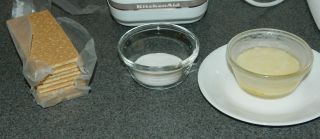 My recipe starts with a quick preparation of the crust. Assemble 4 ounces of graham crackers, 1 tablespoon granulated sugar, and 4 tablespoons of melted butter.
My recipe starts with a quick preparation of the crust. Assemble 4 ounces of graham crackers, 1 tablespoon granulated sugar, and 4 tablespoons of melted butter.  Break the graham crackers into small pieces and place into a food processor.
Break the graham crackers into small pieces and place into a food processor.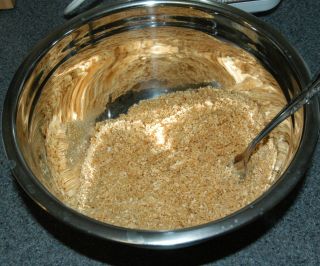 Pulse the food processor until the graham crackers have been reduced to fine pieces (about 10 one second pulses). (The crackers can also be broken by placing them into a large resealable plastic bag and crushed by rolling a pin over the bag.) Then, in a medium bowl, mix the sugar and butter with the crackers until all the crackers take on a wet appearance.
Pulse the food processor until the graham crackers have been reduced to fine pieces (about 10 one second pulses). (The crackers can also be broken by placing them into a large resealable plastic bag and crushed by rolling a pin over the bag.) Then, in a medium bowl, mix the sugar and butter with the crackers until all the crackers take on a wet appearance.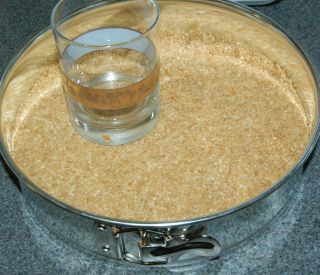 Melt one tablespoon of butter and use half of it to butter the bottom of a 10 in. springform pan. Then, pour the graham cracker mixture into the pan. Use a flat bottomed cup to press the cracker crumbs down into an even layer.
Melt one tablespoon of butter and use half of it to butter the bottom of a 10 in. springform pan. Then, pour the graham cracker mixture into the pan. Use a flat bottomed cup to press the cracker crumbs down into an even layer.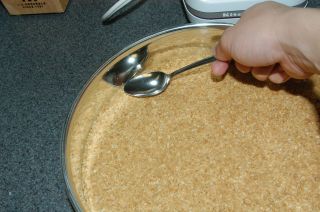 Use a flatware teaspoon to press in the outer circumference of the crust.
Use a flatware teaspoon to press in the outer circumference of the crust.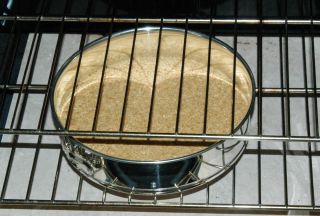 Bake the crust for about twelve minutes at 325°F.
Bake the crust for about twelve minutes at 325°F. Once the crust has become fragrant and turned a golden brown, remove it from the oven to cool on a wire rack. When the crust has cooled, use the remaining half tablespoon of butter to butter the sides.
Once the crust has become fragrant and turned a golden brown, remove it from the oven to cool on a wire rack. When the crust has cooled, use the remaining half tablespoon of butter to butter the sides.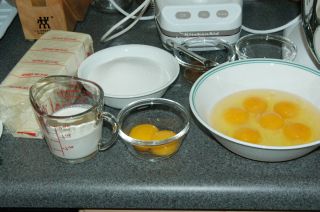 While baking the crust and letting it cool, assemble and prepare the filling: 2-1/2 pounds cream cheese (at room temperature), 1/2 cup heavy cream, 1-3/4 cup sugar, 1/8 tsp. salt, 2 tsp. lemon juice, 1 tsp. vanilla extract, 2 large egg yolks, and 6 large eggs.
While baking the crust and letting it cool, assemble and prepare the filling: 2-1/2 pounds cream cheese (at room temperature), 1/2 cup heavy cream, 1-3/4 cup sugar, 1/8 tsp. salt, 2 tsp. lemon juice, 1 tsp. vanilla extract, 2 large egg yolks, and 6 large eggs.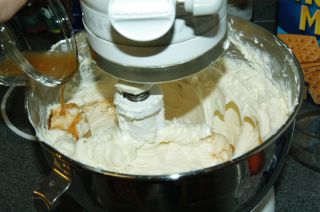 Cut the cream cheese into small chunks and place the pieces into work bowl of a standing mixer. Beat the cheese on low until smooth, about two or three minutes. It may be easier to beat half the cream cheese first, followed by the second half. Once the cheese is smooth, add the salt and about a third of the sugar. Beat until integrated and scrape down the sides. Add another third of the sugar and continue to mix until the sugar is mixed in. Then add the final third of sugar and mix in. Optionally, three tablespoons of flour can be added with the sugar to help add a bit of stability to the cake. Adding flour will not affect the taste or texture of the cake, but will reduce the likelihood of a cracked cake. Add the lemon juice and vanilla extract and mix.
Cut the cream cheese into small chunks and place the pieces into work bowl of a standing mixer. Beat the cheese on low until smooth, about two or three minutes. It may be easier to beat half the cream cheese first, followed by the second half. Once the cheese is smooth, add the salt and about a third of the sugar. Beat until integrated and scrape down the sides. Add another third of the sugar and continue to mix until the sugar is mixed in. Then add the final third of sugar and mix in. Optionally, three tablespoons of flour can be added with the sugar to help add a bit of stability to the cake. Adding flour will not affect the taste or texture of the cake, but will reduce the likelihood of a cracked cake. Add the lemon juice and vanilla extract and mix.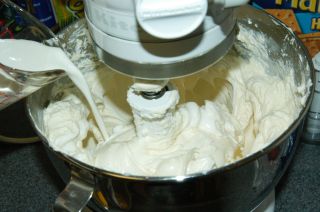 Scrape the sides down and add the heavy cream. The cheese should be much easier to work with at this point.
Scrape the sides down and add the heavy cream. The cheese should be much easier to work with at this point.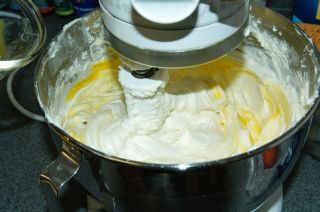 Add the egg yolks and mix until they are blended in.
Add the egg yolks and mix until they are blended in.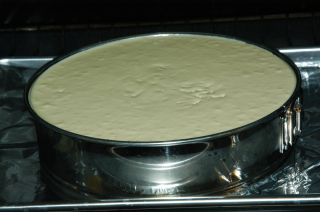 Now add three whole eggs and mix until the eggs have been completely mixed into the filling. Scrape down the sides and beat in the final three eggs. Now, pour the filling into the springform pan onto the cooled crust. A 10-inch pan should fill up to almost its rim with this filling. Lift the pan an inch or two above your counter or cutting board and drop it to bring any bubbles trapped inside to the surface. Place the springform pan onto a sheetpan (for easy handling and safety), and slide into the middle of an oven preheated to 500°F.
Now add three whole eggs and mix until the eggs have been completely mixed into the filling. Scrape down the sides and beat in the final three eggs. Now, pour the filling into the springform pan onto the cooled crust. A 10-inch pan should fill up to almost its rim with this filling. Lift the pan an inch or two above your counter or cutting board and drop it to bring any bubbles trapped inside to the surface. Place the springform pan onto a sheetpan (for easy handling and safety), and slide into the middle of an oven preheated to 500°F.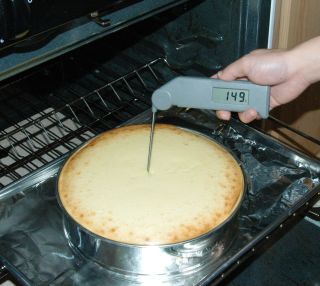 After ten minutes, reduce the temperature to 200°F and allow the cheesecake to bake as the oven gradually reduces temperature (do not open the oven door). Bake the cheesecake until the center of the cake registers as 150°F (making sure it does not exceed 160°F), about 1 hour and 40 minutes. Feel free to use an instant read thermometer in the center of the cake - a slight blemish is worth a perfect cake. Note: When baking the example cheesecake, I kept the cake at 500°F for only five minutes (thinking that the pizza stone would keep the temperature higher for longer). Notice that the edges of the cake had begun to brown, but the whole surface of the cake is still a light shade. This cake resulted in the texture of a New York style cheesecake, but failed to achieve the look. Remember to keep baking at 500°F for the full ten minutes. (Some recipes even call for fifteen minutes, but I generally use ten.)
After ten minutes, reduce the temperature to 200°F and allow the cheesecake to bake as the oven gradually reduces temperature (do not open the oven door). Bake the cheesecake until the center of the cake registers as 150°F (making sure it does not exceed 160°F), about 1 hour and 40 minutes. Feel free to use an instant read thermometer in the center of the cake - a slight blemish is worth a perfect cake. Note: When baking the example cheesecake, I kept the cake at 500°F for only five minutes (thinking that the pizza stone would keep the temperature higher for longer). Notice that the edges of the cake had begun to brown, but the whole surface of the cake is still a light shade. This cake resulted in the texture of a New York style cheesecake, but failed to achieve the look. Remember to keep baking at 500°F for the full ten minutes. (Some recipes even call for fifteen minutes, but I generally use ten.)Related Articles
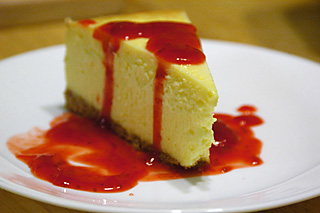 Remove the cake from the refrigerator about thirty minutes before serving and slice with a sharp knife. Use a tall glass of warm water to dunk the knife into between cuts to make slicing easier. The strawberry glaze from the Strawberry Glazed Angel Food Cake works well with this cheesecake.
Remove the cake from the refrigerator about thirty minutes before serving and slice with a sharp knife. Use a tall glass of warm water to dunk the knife into between cuts to make slicing easier. The strawberry glaze from the Strawberry Glazed Angel Food Cake works well with this cheesecake.Plain New York Style Cheesecake (serves twelve)
Graham cracker crust
| Preheat oven to 325°F (160°C) | ||||
| 4 oz. (110 g) graham crackers | process to crumbs | mix | form in 10-in. springform pan | bake 325°F (160°C) 12 min. |
| 4 Tbs. (55 g) butter | melt | |||
| 1 Tbs. (12 g) sugar | ||||
Cheesecake
| Preheat oven to 500°F (260°C) | |||||||||
| 2-1/2 lb. (1.1 kg) cream cheese | mix until smooth | mix | mix in thirds | mix | mix | mix | mix in halves | bake 500°F (260°C) 10 min. | bake 200°F (93°C) 100 min. until 150°F (65°C) |
| 1/8 tsp. (1 g) salt | |||||||||
| 1-3/4 cup (350 g) sugar | |||||||||
| 3 Tbs. (23 g) all-purpose flour (optional) | |||||||||
| 2 tsp. (10 mL) lemon juice | |||||||||
| 1 tsp. (5 mL) vanilla extract | |||||||||
| 1/2 cup (120 mL) heavy cream | |||||||||
| 2 large (34 g) egg yolks | |||||||||
| 6 large (300 g) eggs | |||||||||
| 1 graham cracker crust | |||||||||
Related Articles
I have read in numerous places that you need to be careful not to overbeat a cheesecake batter. I've never had a problem with the top cracking, so I suppose I must not be overbeating it. Or is there actually no basis in that advice? If there is, what is it? Why would overbeating cause the top to crack?
As I understand the potential problems while making a cheesecake, overbeating does not contribute directly to a cracks forming on the surface of the cheesecake. However, overbeating could introduce air bubbles into the batter. If these air bubbles are around while baking, then the bubbles could expand causing the cheesecake to rise. Then, the bubbles will burst (because a cheesecake has very little in terms of structural support - no flour) and the cake will fall. The solution? Use low speeds on your mixer and help the air bubbles rise by lightly dropping the cake before baking. A popular "trick" is to run a knife in a multiple 'S' pattern through the batter after it's been poured to help release air bubbles.
Cracking occurs for a variety of reasons. The three most likely reasons on a cake this size is rapid cooling and under or overcooking of the filling. A cracked cheesecake does not affect taste, but it might be an indicator of texture. The cheesecake shrinks a little when cooled. When cooled rapidly, the cake may not change shape uniformly resulting in a fissure forming through the middle of the top of the cake. It's best to cool it slowly in a warm, moist place. Some recipes suggest cooling in the oven (after it's been turned off), but this takes a really long time and may not be perfectly safe since the cake is kept in the bacterial danger zone for many hours.
If the middle of the cake is not fully cooked, then it might also crack during cooling. Using an instant read thermometer ensures the center of the cake will cook enough to coagulate the eggs while not overcooking. In addition, adding 3 Tbs. all-purpose flour to the recipe (mix in with the sugar) will help bind the cake without a noticable change in texture or flavor. In fact, now that I'm thinking about it, we should include this 3 Tbs. flour whenever we can. I'll add it to the recipe.
The last way I'd expect cracks to form is in the oven. If the center of the cake completely solidifies, the surface will start to crack as more and more liquid evaporates. This used to be a sign that the cheesecake was done, but in fact the interior is a bit overdone. Also, you'll have an unsightly top to your cheesecake. Many of these cracking issues can be avoided by baking in a water bath, but then it wouldn't be New York style anymore.
The table is correct. Please bake the cheesecake at 200°F for 1 hour and 40 minutes.
There's no such thing outside the US, at least not where I live. From the image I'd say they look more like biscuits than regular crackers (as in cheese & crackers). What would you advise as a substitute?
If graham crackers are unavailable, you can try:
vanilla or chocolate wafers
amaretti biscuits
ginger snaps
zwieback
Don't forgot to make crumbs out of these cookies and crackers... Have fun.
In my experience, cracking occurs when the cake spends too much time baking at too high a temperature, but that doesn't necessarily mean the interior is overdone. I've done tests keeping the oven at an even 300-350 for the whole baking time, and the cakes cracked like the devil even though the final color and texture were good. The problem lies in the fact that the filling doesn't cook uniformly.
Solidity starts at the outer surfaces, then works its way in. Cracks occur when the solid layer at the top is about 1cm thick and the filling has puffed enough that the surface is fully domed. Basically, the custard can't stretch enough to take the stress (custards are notorious for low tensile strength), so it breaks and you get a panful of tasty fault lines.
Puffing does *not* occcur uniformly, though. It starts as a ring around the edge of the pan and then moves in to the center. The trick to getting a good, light cheesecake is to have the puffing stop just as it reaches the center, then maintain that level of puff while the rest of the filling solidifies. Give the cake too much heat, and it will crack. Give it too little, and it will collapse.. you'll end up with a bowl-shaped, crumpled top.
The key to controlling puff is knowing when to switch the oven from 500 down to 200. You don't want to wait until the top is fully domed, because the filling will continue to puff while the oven temperature falls, and you'll get cracks. Nor do you want to drop the temperature too early, because the center won't puff and you'll end up with a bowl. 10 minutes is a decent rule of thumb, but really, you have to watch the cake.
I personally drop to to 200 when the un-puffed zone at the center is about 4-5cm in diameter. That happens to be the sweet spot for the cakes I usually make. Your mileage will vary based on the diameter of your pan, the depth of the filling, the amount of air you've whipped into the filling, humidity, your oven, the phase of the moon, and who knows what else. Just assume that your first two or three cakes will be ranging shots, and figure out what works best for you.
That bit of timing is the 'secret' of cheesecake, though.
mike stone
.
This recipe sounded so good, I made it yesterday. We had a small slice with breakfast this morning and my wife declared it the "best cheesecake ever!" It was delicious. Light and fluffy inside and a little denser on the edges.
A few comments/questions:
1. The post says to cook the crust at 350, but the listing at the bottom says 325.
2. I didn't fully understand the part about the tablespoon of melted butter on the bottom of the pan. Are you saying to use 1/2 tablespoon of melted butter? It was confusing because you never mention what to do with the other half.
3. My cake developed a large crack around the other edge after only 20 min. I thought most cheesecakes cracked during the cooling, not the coking. I will mention that mine didn't turn brown after the 10 min at 500. so I gave it another 2 min. Maybe that had something to do with it.
Nonetheless, it was a delicious cake. Thanks for the great recipe and site.
Peter
Whoops. I made a mistake. The crust should be baked at 325°F for about 12 min. I don't think baking at 350&176;F would hurt anything.
re: 1/2 tablespoon butter
Ah, yes. I left out the all important line: "When the crust has cooled, use the remaining half tablespoon of butter to butter the sides." So, yes, use half a tablespoon for the bottom and half for the sides. Sorry.
re: browning and cracking
Although, many consider a "perfect" cheesecake to be a uniformly colored one without blemish, I think the most important aspect is probably taste. You can always top a cracked cheesecake or hide it with clever cutting. In this case, I'm not sure why the cheesecake cracked (often it's hard to tell). There are a few things you might want to try - although, you may be eaten many cheesecakes through this experimental process. (1) Use a water bath to introduce more moisture in the oven. I use a gas oven, sot here is some inherent moisture. An electric may be too dry for a cheesecake (pure conjecture on my part). Try placing a large pan of hot water in the oven on a rack positioned below the cheesecake. (2) If, you kept the door closed the entire time of the bake, then maybe try reducing the temperature a bit faster by cracking the oven door during the transition between 500°F and 200#176;F. Or, perhaps your oven's 200°F isn't 200°F (often the case). (3) If you opened the oven door while baking to peek, try not doing that. :)
Cheesecakes are finicky things and require a bunch of patience to get "perfect". (As you can see with the cheesecake I baked as an example, it did not come out perfectly because I was in a bit of a rush. This just goes to show that perhaps cheesecakes shouldn't be baked on weekday evenings after a long days work and when you have an early morning meeting so you need to get to bed and the cake is still cooling at 1:00 am.)
Good luck!
You really had your work cut out with the responses from this recipe!
One comment - the term 'graham crackers' is confusing. Are they like ritz or jatz (i.e. flaky) or are they like biscuits (i.e. crumbly)?
To overcome the language barrier, perhaps you could describe what they are made of in order for us to work out what they are. I think they are actually available here (in Australia) under a different generic name.
Nabisco is the maker. Here is manufacture's website. http://www.nabiscoworld.com/honeymaid/
BTW, you've probably heard it a hundred times before, but I think your cooking instruction graphs are excellent and a very good idea.
I've had terrible cracks from time to time--mostly they occur because I forget to run a knife around the edge immedimately after taking it out of the oven, and then again before tossing it into the fridge.
When I remove it from the oven, I cover it with loosely with a paper towel and then again with plastic wrap--the paper towel becomes very moist and droops onto the cheesecake, but comes off easily. I'm not sure if it helps keep the moisture in while letting the heat out, but I haven't had a crack when doing this as well as remembering to run a knife around the edges.
For cutting, I've been told the best way to cut it is to take dental floss and press it through the cheesecake, and then pull it out.
I'll definitely have to put this one on the todo queue though =)
-Jefferson
a teaspoon of ground ginger in the crumb base is not a bad addition to the recipe, it a adds a certain something.
I hope this response isn't too late (it probably is), but you can try freezing the cheesecake. In general, fully cooked cheese cakes freeze really well. To thaw, just place them in the refrigerator over night and they should be ready to eat the next day. This freezing, may help to set the center of your cheesecake a bit more.
That helps with the what to do, but why did it happen? I'm not sure. It could be that your instant read thermometer needs recalibrating or the combination of humidity, atmospheric conditions, cooling properties of your pan and environment, who knows causes the cake not to properly set. I would suggest to bake the next cheesecake a little bit longer or try leaving it in the oven with the door cracked open for ten to twenty minutes after you've reached 150°F. Ideally, we want the temperature over 150° but as close to 160°F as possible - but going over 160°F almost always results in cracking.
One of the difficulties of cheesecakes is that you need to make them a few times to get the recipe just right for your ingredients, oven, and location. After investing the time and money, you've got a dessert that everyone will be fighting to get their hands on.
I ended up with some gooeyness at the center of the cheesecake as well, but not too much. I actually cut the cooking time a little short, so it didn't surprise me. I didn't remember to look for a thermometer while looking for a new mixer, so it was mostly guesswork.
Thanks for this article, I'm sure I'll end up experimenting more with it in the future.
and easy. My questions is
Can I use other biscuits like digestive biscuit to subsitute with graham crackers and American cream cheese with Philadelphia Cream Cheese since it is hard to get the same ingredients in South East Asia . To bake the crust,
I would like to mix the butter and crackers only without adding the sugar. Any comments ?
Those substitutions will work just fine. It seems that digestive biscuits are the same thing as graham crackers. In the U.S. graham crackers are made sweet, so the addition of the sugar may not be necessary for those who don't like strongly flavored sweets.
Philadelphia cream cheese is a brand of American cream cheese, so that will work well. In fact, Philidelphia cream cheese is the most popular cream cheese in the United States - so no worries there!
Good luck.
I used the flat beater (not whisk) to beat the cream cheese. I started on low and moved up in speed as the cream cheese began to become smooth - then I slowly stepped up to a low-medium speed (about a 4 on my mixer). When adding ingredients, I moved it back down to low to reduce the possibility of splatter.
One thing I dont get--and this is probably from an inexpert understanding of physics--is how if the cheesecakes are in the oven for an hour and forty minutes the center never reaches the same temperature as the oven. Shouldn't they be reading 200 degrees as well? (Well, obviously they don't since there was a 100-degree difference in mine.) Why is it that the heat doesn't permeate that far?
My thermodynamics is a bit rusty, but a few estimates can be made if we make some simple assumptions.
A 10" cheese cake has a volume of approximately 2600 cm^3 (mL). If we approximate that cheesecake has the density of water and the specific heat of water, then it takes about 10.9 kJ to raise its temperature by 1°C (4186 J/kgC° * 2.6 kg). Starting at 20°C and ending up at 100°C, the water needs to gain about 870 kJ of energy.
Using Stefan's Law, we can approximate roughly how fast energy entered the water with an oven set to 200°C (through radiation):
P = (5.67*10^-8 W/m^2*K^4)(surfacearea)(0.95)(T^4-T0^4)
P = 5.67*10^-8 W/m^2*K^4*(0.14m^2)(0.95)(((373 K)^4-(293 K)^4)
Thus P is about 90 W
This means it takes about 9600 seconds or 2 hour 40 minutes for a body of water the size and shape of cheesecake to reach an average temperature of 200°C.
Likewise a calculation based on 90 W entering the water/cheesecake approximation, shows that after 1 hr. 40 min, 540 kJ of energy has been added to the cheesecake shaped water, raising it's temperature by 49.5 C° to a final average temperature of 69.5°C or 157°F.
Of course all of these calculations are real crude especially since a cheesecake is a bit more complicated than a fat cylinder of water, the specific heat and emissivity of water is not constant (varies a little by temperature), and we don't take into account the pan or conductive heat. (I did quickly glance at how much heat would be conducted from the air to the cake, but it looks like it would be less than a watt, so I ignored it.) Otherwise, this is probably a pretty good estimate.
My oven here in UK has GAS MARK 1, 2, 3,4 etc. Therefore i'm not sure which mark should i put in order to bake this cheesecake. I really wanted to try your recipe. Hope u could help me in this matter.
Many thanx..
I think 500°F is around 10 Gas Mark while 200°F is a little lower than 1/4 Gas Mark.
I suggest using an oven thermometer to see what setting on your oven equates to 200°F since you're going to need to set it lower than the lowest marked value (usually 1 Gas Mark - some ovens go down to 1/4 Gas Mark but we need a bit lower).
For the record, I use the following for rough Gas Mark conversion:
1/4 Gas Mark = 225°F
1/2 Gas Mark = 250°F
1 Gas Mark = 275°F
Each additional Gas Mark is another 25F°.
I must say this is one of the best basic cheesecake recipes I've found. I use it quite often by itself, or as a base for flavored cheesecakes. I've had zero problems with the recipe. In terms of the "gooyness" in the middle that some have reported I recommend this. When removing the cake from the oven, after running a paring knife around the edge-cover the cake with a larger pan and let it cool to room temperature. This will take along time but will set the cake nicely with no sudden drop in temperature. I then refrigerate until cold and then freeze. Freezing the cake is the easiest way I've found to get the cake out of my expensive pans. All in all I don't think you can go wrong with this recipe. Thumbs Up to Michael!
I don't have an electric mixer... do I HAVE to use an electric mixer for mixing the cream cheese and stuff? Would it be a nightmare to mix those ingredients just by simple tools such as... spoons?
I don't have an electric mixer... do I HAVE to use an electric mixer for mixing the cream cheese and stuff? Would it be a nightmare to mix those ingredients just by simple tools such as... spoons?
Seems like a legitimate question to me... and yes, I would say it would be a nightmare to muscle through the cream cheese by hand - but it can be done. Let the cream cheese warm up to room temperature before trying to work with it or you might pull a muscle. If you're using spoons make sure it's nice and sturdy. I'd probably recommend a large spatula (like the ones with silicon spoon ends) or a wooden spoon so you can push your way through the cheese effectively.
It's going to be a lot of work and you probably won't end up with the same texture when compared to using a stand mixer, but with a bit of perserverance and some muscle, you should be able to pull it off.
And what ratio of ingredients help make a cheesecake fluffy?
thanks! - Stacey
Digestive biscuits are suggested as a suitable alternative for British cooks trying to follow American recipes, but they are not exactly the same thing.
P = 5.67*10^-8 W/m^2*K^4*(0.14m^2)(0.95)(((373 K)^4-(293 K)^4)
Since the temp of the oven is 200C, shouldn't your first T read 473K instead?
Secondly, the second T term is not a constant of 293K. Wouldn't it be better to integrate the formula with respect to time as T goes from 293K to Tf (final temperature).
Note: You need to express the T in terms of time and combine the equations.
In Australia, you can use Arnotts Milk Arrowroot biscuits (or a generic brand alternative) to achieve the same result.
This has been a fairly standard recipie for biscuit bases in my family for as long as I can remember.
I served the cheesecakes at a party that my fraternity was having and the females said that the cheesecake was "orgasmic." Thanks to you, i got a few numbers that night, lol. I also used the strwaberry topping from the angel food cake recipe and that also turned out lovely.
My one question would be, coul I possibly replace the heavy cream with egg nog for the holiday season? It was something that came to my mind while making the cheesecake.
I will take this opportunity to introduce myself. I'm 19 years old and I'm a sophomore at the University of Pennsylvania. I'm studying mechanical engineering. When I discovered this website I was quite surprised because I figured that this website would suit me perfectly. However, I have done a lot of thinking and I am now trying to transfer schools so that I may pursue a career in Hospitality Management or Culinary Arts. I love engineering, but my passion for cooking is greater. Once again, I'd like you to know that I'm glad I found this site and these forums and I'm looking forward to staying around.
Substituing the heavy cream with egg nog is an intriguing idea. My guess is that it will work, but you may need to adjust the baking time a little.
i would love to try your receipe of the New york style cheese cake but i live in france and don't know what would be equivalent to cream cheese ? Would ricotta be ok ? I read a receipe that mentionned neufchatel but find it very surprising...
thank you, el.
I can't wait to try this recipe!
One question though, I have a fan-assisted oven and was was wondering how this will affect the cooking times?
M
A convection oven will decrease the cooking time. How much time does it decrease by? I don't know. Anyone with a convenction oven that can give advice?
I'd usually suggest dropping the temperature a bit, but since we're baking at 200°F for most of this, You'll just have to check for doneness earlier. I'd start at least 30 min. earlier in checking the temperature.
I had one possible problem, though. When I took the cake out of the oven to check its temperature it was slightly over 160°F (about 170-180°F). With having no previous experience with cheesecakes I did not know what to do so I just ignored the high temperature and carried on with the rest of the recipe. I followed your directions exactly, what could I have done wrong and if I were to try again what should I do differently?
Not much else to do except carry on with the recipe. The only danger with a high temperature is cracking. Too low and the cake may not set. Next time, shave off a little time from the recipe and check earlier. Baking times are always approximate due to all the possible variables (actual oven temperature, humidity, altitude/air pressure, cleanliness of oven, heating element cycling algorithm, etc.). Now that we know your cheesecakes bake faster than mine, just cut off fifteen minutes and check. If it's still too hot, then next time cut off some more time.
To remove the entrained air after mixing it, I thumped the (plastic) bowl on the counter a number of times, and let it sit for a while before pouring it into the pan. There were a few small imperfections on the finished cheesecake after baking it, where a few small bubbles rose to the surface and popped. They could have been eliminated by letting it sit for longer. There was no problem with cracking.
It was quite brown on the surface when I took it out of the oven, something I wasn't prepared for with your photos. But the texture and flavor were perfect, so I assume that's how it's supposed to be. I expected a more "golden" brown.
Everyone loved the cheesecake who tried it. Next year I'll be making two, so that I can take one to the extended family gathering.
This also minimizes waste. You're going to need that mixing bowl anyway, to add the sugar and butter. This way, there's no wasted bag and no dirtied food processor bowl/blade. And you can reuse the glass when it comes time to press the crumbs into the pan.
Hopefully it's not necessary to say this, but don't put all your weight onto the glass. You're just crushing graham crackers. You don't need too much force, and no one wants to break a glass (possibly casuing injury). You'd have to press pretty hard to break a pint glass that way, but it is possible. So basically, don't be stupid.
i would love to try your receipe of the New york style cheese cake but i live in france and don't know what would be equivalent to cream cheese ? Would ricotta be ok ? I read a receipe that mentionned neufchatel but find it very surprising...
thank you, el.
Can you not get cream cheese in France? In Germany it's available. Italy, too, apparently, though the Italians I knew referred to it by the brand name "Philadelphia" and had no clue what I was talking about when I said "cream cheese". Perhaps it's the same in France? Perhaps you can get "Philadelphia" cheese, but it's just not called cream cheese?
But from what I've read, yes, neufchâtel is an acceptable substitute, but it's less moist and lower-fat. Maybe you might want to add a bit of extra cream (and use a bit less cheese) if you make this substitution. According to this page, cheesecakes made with neufchâtel cook faster and are more prone to cracking, so keep a close eye on it.
I am going to try this recipe to see about the texture especially. I tend to make flavored cheesecakes which are usually quite dense, and use a lower egg/creamcheese ratio.
If your oven is giving you problems, I'd get an oven thermometer to see if the oven is hitting the correct temperature. If your consistently undercooking the food, then the solution is to simply either increase the temperature or cook it longer. If you don't have an oven thermometer, then I would probably suggest simply cooking your food longer instead of trying a higher temperature. Some baked goods don't work out well if you bake at too high a temperature and it's impossible to accurately gauge an oven's temperature without a thermometer.
I baked a 9" and also used the remaining batter on smaller cake pans (perfect for gifts). I did the 500 degrees for 10 minutes and then 200 for 1 hour and 30 mins. When testing the temperature, my thermometer registered 170+!!! I was so worried but the cake looks fine. It appears as it should, but perhaps overbaking it just results in a stiffer cake? Again, I haven't actually tasted the finish product so I can't say for sure how the texture is. I did remove the smaller cake pans much earlier and they are rather good.
I do have a question though. Can the ingredients be combined all at once? rather than doing thirds and halves? What is the purpose of that?
I will attempt your other recipes next. Thank you again.
We add sugar to the cheese in thirds to help ensure an even distribution of sugar throughout the mix without mixing for a long time. Adding all the sugar at once makes it more likely for clumps of sugar to be deposited in the thick cheese.
Let the cream cheese set for several hours until it is soft at room temp. You can even cut it up and throw it in the microwave for a short 10-20 sec.
Then just use a stout whisk and a large bowl. Mixing this will take a little muscle work at first, but by the time you add the eggs and cream the batter will loosen up enough to mix more easily. Don't leave any lumps of cream cheese. You may have to do several bursts of elbow grease to prevent lumps, but if the cheese was soft to start with you'l be OK.
You can also use a big food processor with the chopping blade. Mix in batches if needed, then use a decent whisk and a big bowl to combine batches.
Ours is very dark brown around the edges (but still moist - not burnt) and when I took it out it was registering around 160 F, so I think I may have left it a little long. It cracked somewhere in the last forty minutes of cooking so maybe that's related. Fortunately the crack's pretty much right down the middle!
I also opened the oven door a couple times during the first ten minutes of cooking at 500 F to check on how much of the cake was rising (a previous poster suggested waiting until the diameter of the un-risen section was 4-5 cm), but almost none of mine noticeably rose more than the rest so after thirteen or fourteen minutes I decided just to bring it down--perhaps that had something to do with it too.
Thanks for this amazing recipe! And thanks for making all the recipes so readable. I never "get" the cooking websites, but this site actually makes cooking enjoyable because I know what I'm doing and why.
i have a 30 quart hobart type...and i'd like to start making cheesecake in quanity. :shock:
A brown "skin" at the top of your cheesecake is actually a desired appearance for New York-style Cheesecake. It sounds like your oven is still too hot though because your cake cracked. Either lower your temperature a but more (try 200°F) or remove the cake earlier from the oven before it gets a chance to over cook.
A water bath does cook a cheesecake more gently and provides a larger window where pulling it out of the oven will result in a non crack cheesecake, but then the cheesecake wouldn't be New York style. New York style cheesecakes do not employ water baths. I have to get around to making more types of cheesecake, so my readers will have more versions to choose from.
Oh... and to Stacey [August 15th], for a fluffy-type cheesecake, you use a lot less cream cheese (about 200gm or 1 tub of Philly's) and yes, you do beat the egg whites... There should be some recipes on the Net that can be of help. ^_^
Michelle
I use Petite Beurre for the crust...
A guest, Stacy, asked on Aug 15, 2005, what ratios would make it more fluffy. I saw no reply.
I have been trying to figure out how to make it less fluffy, very creamy, yet firm enough to cut and stay on a fork.
Well, I sorta know why your question has been ignored.
I have tryed a few "lower fat" cheese cakes in the past (cooked by me and prefessional chefs) and I can tell you, the best you will get is a dense, tastless, dry cardboard texture and it aint nice!
The best you can do is have a smaller serving or just let your self splurge and have a nice scoop of home made white chocolate ice cream a strawberry compot and a big slice of cheese cake!
Gradually decrease from 500F to 200F?
No, a smoking oven is probably not a good thing. It sounds like you either need to clean the oven (use the self cleaning option if you have it; if not, do it manually) or get it checked out. Most likely it's a cleaning issue - the smoke is from food particles or ingredients that have fallen into the oven from previous baking endevours. As increase in temperature, they start to burn, giving off the smoke.
I was wondering whether the smoke could have been a result of the oven temp surpasses the smoke point of the butter used in the cheesecake.
And yes, you are correct, my oven needs a major neat scrub.
That is unlikely unless you baked the cheesecake for a whole day. The temperature your butter (in the batter) is at when you slide it into the oven is probably a bit less than room temperature - say 65-70 degrees F. By the time you remove it, it'll only have reached 150 degrees. Far lower than the smoking point. What is causing the smoke, is any other material that may be in your oven. Since this material is fairly small, it heats up quickly as the oven heats up and then begins to smoke and burn.
Very nicely explained. This is the single best NY cheesecake recipe I've seen, and I've seen (and cooked) many. In fact I was googling for a better one because I was dissatisfied with most of the ones I've seen over the years.
I love this recipe, but I am trying to find information on size variations. I want to make an 8 in, a 9in, and a 10 in cheesecake. Would I just use the recipe you have and fill the forms until full??? How would this effect baking times and temps???What do you suggest to make this cheesecake without a crust. Some of my family love cheesecake, but without a crust.
Thanks so much
Graham crackers: I'm in Germany. You can't (easily) get digestive biscuits or Graham crackers here, but taking normal "butterkeks" worked out fine. By the time it's all baked, you'd never be able to tell butterkeks had played a rôle in the base.
Density: goodtogoth, it's definitely dense (at least, mine is).
Heavy cream is cream with more fat than normal - about 40%. You can use normal Schlagsahne. In the supermarkets in NRW, you can also get "Schlagsahne wie damals" or something - which doesn't have 40% fat, but does have 35% or something - at least closer to 40% than normal Schlagsahne (about 30% as far as I remember). I used this for my cheesecake, all went well. It's a normal 200ml pot of cream with a cream-coloured lid and brown writing.
For other (savoury) recipes where Michael used heavy cream, I've sometimes used Creme Frâiche, though I don't think that would apply here.
Good luck with the cheesecake.
[Added later]
I forgot to mention - especially if you're stirring by hand, you won't want to worry too much about the consistency of the cream - the stuff'll be thick enough from the cream cheese. Your arm will thank you for the thinner consistency from adding the cream...
I really recommend letting the cream cheese get to room temperature before mixing. My small mixer almost bit the dust.
Thanks for your great page!
Thanks for all your help...my email is: carolina_dimas@yahoo.com
:)
Try just using normal whipping cream (with about 30% fat). For this recipe, I don't think it will end up making too much difference.
Thanks in advance for your help. My family REALLY will appreciate it!
I've never made a 4-in. cheesecake. I would suggest a trial run first - bake for 10 min. at 500°F and then lower the temperature to 200°F just like the original recipe. Instead of baking for over 1-1/2 hour, bake for 30 minutes and then check on doneness every 5 minutes. That will give you a ballpark figure for how long it will take to bake the rest of the cheesecakes. (I'm guessing it will take 40 min. at 200°F.)
In a springform pan, graham cracker crusts are generally formed on the bottom only. If a side crust is desired, that is often pressed onto the sides by hand.
I'm not sure, but giving it an extra 5 minutes before turning it down should be fine.
http://img.photobucket.com/albums/v11/NashvilleSinger/IMG_0002-1.jpg
http://img.photobucket.com/albums/v11/NashvilleSinger/IMG_0003-1.jpg
Hope everyone enjoys this recipie!
Would I need to change any ingredients? Baking time and temp is what I really need. It has taken me forever to find a great recipe.
I live at high altitude ~ 4100
Thank you! Please help ASAP, I need this help before Friday. :unsure:
Would I need to change any ingredients? Baking time and temp is what I really need. It has taken me forever to find a great recipe.
I live at high altitude ~ 4100
You can try the baking times for the Cheesecake Cupcakes recipe. Presumably you'll be making multiple batches taking only about 15 min. each, so you can adjust your baking time for the next batch as each batch comes out to figure out the precise time you need for your oven and pans.
Making a cheesecake in a cake round is a problem when it's time to extract the cake from the pan without marring the cake. I think there might be an elobarate way to line the pan with parchment paper (along the sides and covering the bottom with extra pieces acting as flaps of a sling to life the cake out of the pan) but you'll probably end up deforming the cheesecake as you remove it. I recommend putting $10 into a springform.
Do you have any great recipes for wild mushrooms? I am always looking for good ones to post on my site. (oregonmushrooms)
:)
It would be interesting to hear people's ideas and recipes for flavoured varieations.
Run the knife along the edge after about ten minutes of resting. Release it from the springform after it has fully cooled and chilled. The cake should have shrunk a little, pulling away fromt eh sides that you released it from in the previous step.
Middle is where the rack should be, but since you're burning the top of the cheesecake, I'd either reduce the time or lower the heat a little (the oven is probably running hot).
As far as I know, this would be the "normal" ingridient in germany.
H Greene
Heavy cream and heavy whipping cream are the same product. In some areas, double cream is available and heavy whipping is not. Double cream has about the same fat percecntage of heavy cream, so it will work too.
But l'll have to take her word for it, because I'm vegan. Seriously reconsidering that right now, as the smells waft across the house. As for my mom's recipe, it came from a Spadina Ave, Toronto, Jewish delicatessen she worked in circa 1962. Wonder if Lottman's Deli is still there. See, this is why, the mom approving of this here cake, well, it's like... praise from Caesar. And I "can't" eat it. Not in a box, not with a fox. Any tips for the tofutti crowd would be appreciated. I once had a vegan cheese cake made from pearl barley. It was very nice, and I hadn't even been a veggie for that many years at the time, at the time I still ate "real" cheese cake, all the same the pearl barley version was very good. Authentic. Baked. Better than the whipped up soft serve version most people are serving nowadays.
Well I am baking two cakes tonight, one for the kids' french class pot-luck, and one for my sweet-heart's graduating high school students (Disadvantaged teens and young adults, many of whom live at the shelter and some of whom have literally no food to eat at home most days. Oh, and one who is finishing high school so that his employer, the Canadian military, can send him to Afghanistan right after his 18th birthday. I figure, if you have to graduate high school without having your mother do your laundry for you, let alone that kind of adversity, all the while making it to class during another city transit workers' strike, then I will personally bake you a cake. And grade four is no fun either.)
They are both instructed to introduce the cakes as my own special casserole. Later we will compare notes as to whether the grade four crowd or the grade fourteen crowd is more appreciative of free cheese casserole.
Thank you for the help with the baking time and proportions. Even if you left out a few vital ingredients. Twenty bucks worth of dairy certainly warrants another couple bucks for a vanilla bean. And you don't need a mixer. I did it by hand, and I'm a gimp cripple. The kid mixed a bowl up, and she weighs like, fifty pounds. Be a man about it. Or a woman, or a human, about it. Mix it by hand = mix it with love. Baking is a sacrament. Don't knock it together with power tools.
-SoyBoySigh.
Eleni from Greece
I am willing to try again - and was wondering if I should increase the temperature as well as adding a couple of Tablespoons of flour.
Any comments and ideas? Thank you.
- 1 package (8 oz.) graham crackers
- 1/3 cup brown sugar
- 3 Tbsp. butter, melted
Regarding high altitude: I live in Utah at about 5000 feet and the recipe works perfectly for me. I use 2 Tbsp. of flour in the batter and cook it for an extra 2 - 3 minutes at 500 degrees.Ive made this cake a few times, and believe me you, its the REAL thing!! i live in Finland and use digestive cookies for the crust. Lucky for us, we can get philly here too...
just wanted to compliment on the recipe and the instructions, this is one hell of a cake!
thanks, Jouna
in ml and gr or oz please
Also, if you will run a very sharp thin blade (a filet knife works great) around the edges of the cake after baking, the sides will break away from the pan easier, resulting in less tension and less chance of cracking. No matter what you do, the filling will cool faster in some areas, slower in others, and if there is tension pulling it in any direction, a crack will result at place where the most drastic temperature change takes place, usually slightly off center of the cake.
There are other factors, but I saw those omitted from the above posts.
Very cool 110 225 1/4
120 250 1/2
Cool 140 275 1
150 300 2
Moderate 160 324 3
180 350 4
Mod-Hot 190 375 5
200 400 6
Hot 220 425 7
230 450 8
Very Hot 240 475 9
My suggestion is that you press the cream cheese through a sieve before you start mixing it.
You can also use a big food processor with the chopping blade. Mix in batches if needed, then use a decent whisk and a big bowl to combine batches.
I am renting an apartment and I have a very small oven that heats up fast. Should I still put the cheesecake on at 500 degrees in the beginning?
Thanks.
Since the 500 degrees is the preheated temperature, it doesn't matter if your oven preheats quickly. I recommend starting at 500 degrees.
Great cheesecake recipe! I got one problem, after I cut the cheesecake, I put the leftover in a plate and I got some liquid and the crust is not dry anymore, anyone have an idea why I got this problem?
Best regards,
Charles
Great cheesecake recipe! I got one problem, after I cut the cheesecake, I put the leftover in a plate and I got some liquid and the crust is not dry anymore, anyone have an idea why I got this problem?
Best regards,
Charles
Hi Charles,
Did you use a waterbath anyway? Don't use next time and see how it goes. :unsure:
Good luck.
I use a waterbath but with a real pan not a spring pan so no chance to have water in the pan. Maybe it's because I don't let cool enough! How long do you let cool the cake? I wait one hour before putting in the fridge!
It's look like the butter dissolve with the crust (yellow liquid)
Best regards,
Charles
Thank you!
I am using a recipe that uses 5eggs/ 4pkg 8oz cream cheese/ 1 can pumpkin, brown sugar and 1/4c of flour, and general spices.
Any suggestions or ideas that you could provide would be greatly appreciated
thank you, nancy
For something like cheesecake which contains a significant amount of dairy, we usually say three days. But, they can last much longer - it's up to your own judgment whether or not it is safe to eat. If it has been under consistent refrigeration, doesn't smell, look, taste, or feel funny and it hasn't been longer than a week or so, then you can make your own judgment call. I'm not going to tell you it's okay to eat, because I haven't seen it, but if you're a hardy individual, go for it. If you're prone to illness, elderly, have weak immune system, have a propensity for diarrhea, then maybe you should skip.
Sounds like massive overcooking. Your cheesecake is cooking much faster than the recipe, so heat is entering rapidly. This means the sides of teh cheesecake will be much hotter than the interior, so if the center is over 160, then over the next 20-30 minutes, it will continue to rise as the heat from the sides transmit into the interior. The overcooking would cause the cracking when it cools and the size of the crack will be proportional to the amount of overcooking that occurred.
Check your oven and see if it's a convection oven. If it is, turn off the convection - we want to slowly bring the temperature up. You can also try turning down the heat (and introducing a water bath to even out the temperature a little) if that doesn't help.
Cheesecake is not something you want to cook rapidly. The key is evenly bringing up the temperature of the cheesecake, so lower heat for longer time is what you want. Turning the circulation fans on your convection oven will heat up the outside of the cheesecake way too fast. You can use the convection oven for the first few minutes, but once you lower the temperature, put it on conventional mode and let it cook for the hour and a half or so needed.
thank for the recipe
http://dessert-recipes.webs.com/index.htm
As an Ex-pat living in the Philippines, still liking my home style treats, I do baking on the side as a hobby. Some of the things that I have learned are" no two ovens are the same, you need a thermometer.
If using convection oven (counter top) lower temperature 25 degrees and cook following directions.
My oven in PI uses the top and bottom element to bake, where in the US only the bottom element is used, so I have to tent my cheese cake to prevent browning or I get that burned look.
Here I use "all purpose cream (UHT)" for the heavy cream. (for sour cream I add lemon juice)
For the crust try different things, a mixture of ground nuts, cookies, any sweet baked confection. Sandwich cookies (biscuits) are good and require no added sugar, or butter. For non-filling cookies (biscuits) Just add about 4 Tbls. butter to the crumbs. I freeze my pans with crust before I fill it to cook, holds crust in perfect position, and retards cooking on the edge for a short time.
As a word of help, don't be afraid to add or try something different, use recipe as a guide, not as a law.
Happy cooking from the land of smiles. :D
Nenetheless the cake is delicious and I served it with a raspberry sauce which complemented it perfectly
1 1/2" to 2" not done. The third time I let it cook for about 3 and half hours (maybe more, I lost track) and it came out perfect. I love this recipe, the taste is amazing, but should it take that long?!?!?!?
A couple things to check:
1. What diameter springform pan are you using (and what is it made of, aluminum, steel, glass bottom, etc.)
2. Do you have an oven thermometer in the oven to verify that it reaches 500F and ends up at 200F? Ovens are notoriously inaccurate and their accuracy can change over time also.
It seems to me that 3.5 hours is a LONG time for this recipe.
.......The third time I
First: going out on a limb here....but I am assuming the third time for the cheese cake was not for your third wedding, so I salute your foresight in trying stuff before hanging the proverbial hat on it.
or veil, as the case may be.....
...should it take that long?...
no
but
(your knew that was coming, eh?)
'home oven' temperatures are not the Acme Best Certified in temperature accuracy. plus or minus fifty Fahrenheit degrees is not unheard of - actually more common than un-<anything>
water boils at 212'F - looking at the baking temps, 300, 200 - thats dag'gum close to 'water not going to go away anytime soon' - hence if the oven is off in temperature, 'that long' may be 'right'
so by all means, if you have future plans that include 'that oven' get a thermometer and double check it's dials . . . .
lie in the new oven.... yes its new... hey what a way to test it, huh?
Thanks a lot for posting this recipe!
Just one question, does different types of oven cause the cake to bake differently. I use a water-based oven, the kind that uses water to heat the oven up..some new techie...and my cake appears to be brown very quickly and makes it unsightly. The taste is still great though. But I would appreciate it if someone could tell me how do I prevent the cake from browning in the middle too quickly.
over browning can be reduced by covering the c-cake with aluminum foil for portions of the bake cycle. do double